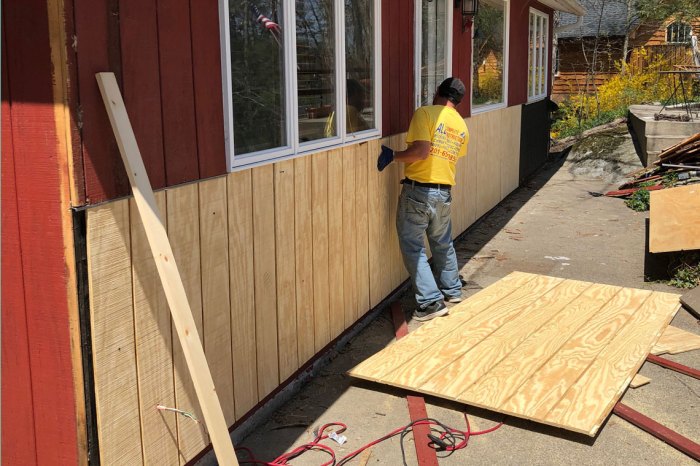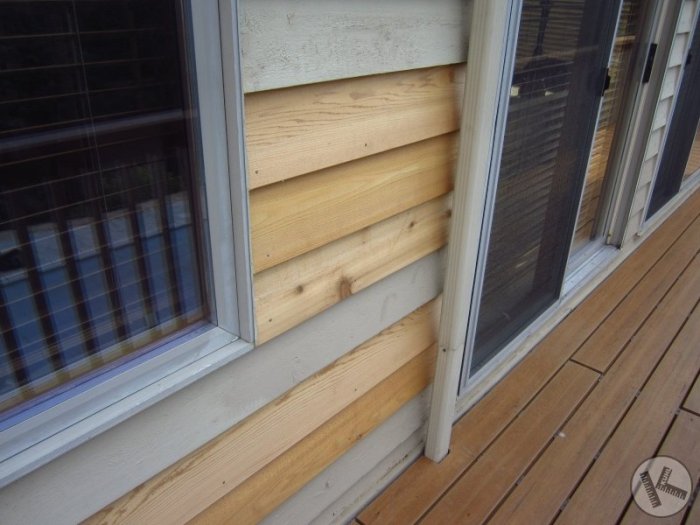Replacing Wood Siding: A Comprehensive Guide to Enhancing Your Home
Exploring the world of replacement wood siding opens up a realm of possibilities for homeowners looking to add charm and character to their dwellings. From the rich hues of cedar to the classic appeal of pine, the options are vast and varied, each with its own unique advantages and drawbacks.
This guide will delve into the intricacies of wood siding replacement, offering valuable insights and practical advice for a successful renovation project.
As we navigate through the different types of wood siding, the installation process, maintenance tips, and cost considerations, you'll gain a deeper understanding of how to elevate the aesthetics and functionality of your home with this timeless and versatile material.
Types of Wood Siding
Wood siding is a popular choice for homeowners due to its natural beauty and durability. There are several types of wood siding available in the market, each with its own unique characteristics. Let's take a closer look at cedar, pine, and redwood siding options to help you make an informed decision for your replacement wood siding project.
Cedar Siding
Cedar siding is known for its natural resistance to rot, decay, and insects, making it a durable option for exterior applications. It has a beautiful grain pattern and is available in various finishes to suit different architectural styles. However, cedar siding requires regular maintenance, such as staining or painting, to protect it from the elements and preserve its appearance.
Pine Siding
Pine siding is a more affordable option compared to cedar and redwood. It is easy to work with and can be stained or painted to achieve the desired look. However, pine is less durable than cedar and redwood, making it more prone to rot and decay if not properly maintained.
Regular sealing and painting are essential to prolong the lifespan of pine siding.
Redwood Siding
Redwood siding is prized for its rich, natural color and resistance to insects and rot. It is a premium option that offers superior durability and longevity compared to cedar and pine. Redwood siding requires minimal maintenance and can last for decades with proper care.
However, the higher cost of redwood may be a limiting factor for some homeowners.
Installation Process
Installing replacement wood siding can be a straightforward process if done correctly. Below is a step-by-step guide on how to install wood siding, along with the necessary tools and materials needed for a successful installation.
Step-by-Step Guide
- Prepare the Surface: Ensure the surface where the siding will be installed is clean, smooth, and free of any debris or old siding.
- Measure and Cut: Measure the dimensions of the area to be covered and cut the wood siding panels accordingly, leaving some room for expansion.
- Prime and Paint: If the wood siding is not pre-finished, prime and paint the panels before installation to protect them from moisture and UV damage.
- Install Starter Strip: Begin by installing a starter strip at the bottom of the wall to provide a level base for the first row of siding.
- Install Siding Panels: Starting from the bottom, nail the siding panels to the wall, ensuring they overlap correctly to prevent water infiltration.
- Apply Trim: Finish the edges and corners with trim pieces to give the installation a polished look and provide additional protection.
- Seal Joints: Seal any gaps or joints between the siding panels with caulk to prevent water from seeping behind the siding.
- Finish and Inspect: Once all the panels are installed, inspect the siding for any gaps, loose panels, or imperfections, and make any necessary adjustments.
Tools and Materials Needed
- Hammer or Nail Gun
- Tape Measure
- Saw
- Level
- Primer and Paint
- Caulk
- Nails or Screws
- Trim Pieces
- Safety Gear (Gloves, Goggles)
Common Mistakes to Avoid
- Not properly preparing the surface before installation, leading to poor adhesion and potential damage.
- Incorrectly measuring and cutting the siding panels, resulting in ill-fitting pieces that compromise the installation.
- Skipping the priming and painting step, leaving the wood vulnerable to moisture and weather damage.
- Not sealing joints and gaps properly, allowing water infiltration and potential rotting of the wood.
Maintenance and Care

Regular maintenance is crucial for preserving the beauty and longevity of replacement wood siding. By following a maintenance schedule and taking proactive measures, you can extend the lifespan of your wood siding and protect it from damage.
Importance of Regular Inspections and Repairs
Regular inspections of your wood siding can help catch any issues early on before they escalate into major problems. Look out for signs of rot, moisture damage, or pest infestations. Prompt repairs can prevent further damage and prolong the lifespan of your siding.
Tips to Protect Wood Siding from Moisture, Rot, and Pests
- Regularly clean your wood siding to remove dirt, debris, and mildew. Use a gentle cleaner and a soft brush to avoid damaging the wood.
- Inspect the caulk and sealant around windows, doors, and other openings to ensure they are intact and prevent water infiltration.
- Trim any trees or bushes near your wood siding to prevent branches from rubbing against or falling onto the siding.
- Apply a protective finish or stain to your wood siding to create a barrier against moisture and UV rays.
- Keep an eye out for signs of pest infestations, such as holes, sawdust, or insect activity. Address any pest issues promptly to prevent damage to your siding.
Cost Considerations
When it comes to replacing wood siding, cost is a significant factor to consider. From materials to labor costs, understanding the breakdown of expenses can help you make informed decisions about your siding project.
Factors Affecting Cost
- Material Costs: The type of wood you choose for your siding, such as cedar, redwood, or pine, will impact the overall cost. Higher quality woods tend to be more expensive.
- Labor Costs: Hiring professionals for installation can add to the total cost. Prices may vary based on location and the complexity of the project.
- Additional Supplies: Nails, paint, sealants, and other supplies needed for installation and maintenance can also contribute to the total cost.
Wood Siding vs. Other Materials
While wood siding may have a higher initial cost compared to materials like vinyl or fiber cement, it can offer a unique aesthetic appeal and natural beauty that other materials may not provide. Keep in mind that wood siding may require more frequent maintenance, which can add to long-term costs.
Cost-Effective Maintenance Tips
- Regular Inspections: Check your wood siding for signs of damage or wear, and address any issues promptly to prevent further damage.
- Cleaning: Regularly clean your siding to remove dirt, mold, and mildew, which can degrade the wood over time.
- Sealing and Staining: Apply sealants and stains to protect your wood siding from moisture and UV damage, extending its lifespan.
Last Word

In conclusion, replacement wood siding is not just a practical choice for your home, but a design statement that can withstand the test of time. By following the guidelines Artikeld in this guide, you'll be well-equipped to make informed decisions and create a lasting impact with your siding project.
Whether you opt for cedar, pine, or redwood, the beauty of wood siding lies in its ability to transform your home into a cozy retreat that exudes warmth and elegance.
FAQ Guide
What are the key differences between cedar, pine, and redwood siding?
Cedar offers natural insect resistance and durability, while pine is more affordable but requires more maintenance. Redwood boasts natural beauty and longevity, but comes with a higher price tag.
How often should replacement wood siding be inspected?
It's recommended to inspect wood siding annually for signs of damage, rot, or pest infestations. Regular upkeep can help prolong its lifespan.
Is wood siding more expensive than vinyl or fiber cement?
While wood siding can have a higher upfront cost, it offers a timeless aesthetic and can increase the value of your home in the long run.




